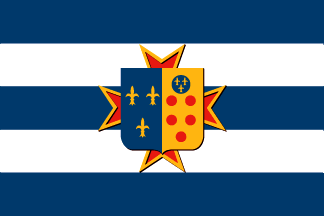 image
by Mario Fabretto, 11 June 1997
image
by Mario Fabretto, 11 June 1997 
Last modified: 2013-01-20 by rob raeside
Keywords: italy | etruria | etrurian kingdom | parma | fleur de lys | tuscany |
Links: FOTW homepage |
search |
disclaimer and copyright |
write us |
mirrors
 image
by Mario Fabretto, 11 June 1997
image
by Mario Fabretto, 11 June 1997
See also:
This is Kingdom of Etruria State flag 1/1/1804 - /12/1807.
Sources:
A. Ziggioto "Le bandiere degli Stati italiani" on
"Armi Antiche" (1970)
A. Ziggioto "Le bandiere degli Stati italiani
pre-unitari" on Vexilla Italica 1, XXIV (1997)
Mario Fabretto, 11 June 1997
Five stripes light blue - white, with the arms in the middle.
Alessandro Martinelli, 29 January 1996
Why the fleur-de-lys? I'm assuming from the dates that Etruria
was a Napoleonic satellite state, so I can't imagine they stand
for the Bourbons... had the fleur-de-lys come to stand in for
"France"?
Joshua Fruhlinger, 12 June 1997
Josh was wondering about the shield of France in the Etruria
arms 1804-1807. Well, the Kingdom of Etruria was given by
Napoleon to the Bourbon-Parma family, hence the fleurs-de-lys.
Source: Francois Veled's heraldry site.
Nahum Shereshevsky, 13 June 1997
Napoleon established Etruria in 1801 for Louis of
Bourbon-Parma (a relative of the Bourbon Spanish king). Louis's
son (Charles Louis - Carlo Luigi in Italian?), inherited the
Etrurian throne in 1803. He was removed in 1808 and Napoleon then
revived the Grand Duchy of Tuscany to Elisa Bonaparte. I think
the territory may have been annexed to France at some time after
that[?]. The Encyclopeadia Britannica (an older edition) says
that Spain tried and failed to have Etruria restored to Charles
Louis at the Congress of Vienna. It looks as though the
fleur-de-lys is a Bourbon symbol (though I'm not sure just how
Bourbon the Bourbon-Parmas were).
Jamie Woods, 12 June 1997
Etruria flag was light blue, white, light blue, white, light
blue, with shield in center. The merchant ensign was light blue,
white, light blue without shield (i. e. the Argentine flag
without sun) Etruria was suppressed 1807 and its territory annexed
to the restored Great Duchy of Tuscany.
Jaume Ollé, 13 October 1998
The Kingdom was indeed created by Napoleon (out of Tuscany)
for the Bourbon-Parma in exchange for the Duchy of Parma, which
was annexed to France. The kingdom was short-lived, as Napoleon
gave it to his sister in 1808. The first king of Etruria was
Louis of Bourbon-Parma, who died prematurely in 1803, leaving his
widow as regent queen and his son Charles Louis as king.
The arms on the flag are Bourbon (for the Bourbon-Parma) and
Medici (for Florence). The Bourbon-Parma descend from Philip V
king of Spain (grandson of Louis XIV and the first Bourbon king
of Spain) and Elisabetta Farnese, heir to the Duchy of Parma. The
wife of Louis, and hence queen of Etruria, was Marie-Louise,
daughter of Charles IV (Carlos IV) king of Spain. The Dukes of
Parma were, in order, Carlo I (later to become king of Naples as
Carlo VII, giving rise to the Bourbon-Sicilia branch, and later
king of Spain, as Carlos III, giving rise to the present Spanish
branch), followed at Parma by his brother Filippo, head of the
Parma branch of the Bourbons. The next duke was Ferdinando,
followed by Louis (Ludovico, to become king of Etruria), followed
by Charles-Louis (Carlo Ludovico), etc.
Etruria was not restored to the Bourbon-Parma. Instead, after the
fall of Napoleon, it reverted to being a Grand Duchy, with the
Grand Duke from the house of Habsbourg. Carlo Ludovico was made
Duke of Lucca, as Napoleon's wife, the ex-empress of France,
Marie-Louise, was made ruler of Parma until her death. Then at
her death the Duchy of Parma reverted back to the Bourbon Parma.
For those more interested in this short-lived Kingdom, I
recommend "La reine d'Etrurie" by Sixte de Bourbon
(Parme), 1929, out of print and in French.
Piero Telesio , 15 October 1999
Roberto Breschi, in his presentation: "Flags in
Italy under Napoleon's pressure" at ICV 20 in Stockholm,
reported about the Etrurian Kingdom: The 5-stripes flag was the
state and war flag while the civil flag had only three stripes
(b-w-b). Small vessels use the three-stripes flag without the
Coat of Arms.
Dov Gutterman, 4 August 2003